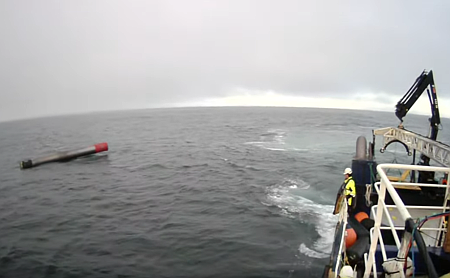Rocket Lab to refly a recovered first stage

Rocket Lab today announced that a first stage used on a launch in January and recovered successfully from the ocean, as shown to the right, has now been moved into its normal production line for preparation for a reflight on an upcoming launch.
The stage was successfully launched and recovered as part of the ‘Four of a Kind’ mission on 31 January 2024 and has already passed more acceptance tests than any other recovered Electron stage, including:
- Tank pressurization test – a process that filled the carbon composite tank with inert gas and held it in excess of maximum operating pressure for more than 20x longer than the standard Electron flight duration
- Helium leak check – a stringent process that determines there are no leaks in the tank
- Carbon fiber structural testing – including ultrasonic assessment and other non-destructive tests to confirm no delamination of the carbon composite tank fibers.
The stage will now undergo final fit out and rigorous qualification and acceptance testing to the same standard as a brand-new Electron tank to determine the recovered stage’s suitability for reflight.
No actual launch date has been set. The company first wants to complete its final testing. If successful and the stage flies again, Rocket Lab will join a very elite club, becoming only the second entity anywhere — after SpaceX capable of reusing a significant part of its rockets. That capability will allow it to drop prices, and better compete.
This success also underlines the lack of creativity from more than a half century of managers and rocket engineers, who repeatedly insisted such reuse was impractical, or impossible. The idea of recovering a stage from the ocean and reusing it was considered crazy, so no one ever tried it. Rocket Lab is about to prove more than a half century of managers and rocket engineers wrong.
Hat tip to BtB’s stringer Jay.

Rocket Lab today announced that a first stage used on a launch in January and recovered successfully from the ocean, as shown to the right, has now been moved into its normal production line for preparation for a reflight on an upcoming launch.
The stage was successfully launched and recovered as part of the ‘Four of a Kind’ mission on 31 January 2024 and has already passed more acceptance tests than any other recovered Electron stage, including:
- Tank pressurization test – a process that filled the carbon composite tank with inert gas and held it in excess of maximum operating pressure for more than 20x longer than the standard Electron flight duration
- Helium leak check – a stringent process that determines there are no leaks in the tank
- Carbon fiber structural testing – including ultrasonic assessment and other non-destructive tests to confirm no delamination of the carbon composite tank fibers.
The stage will now undergo final fit out and rigorous qualification and acceptance testing to the same standard as a brand-new Electron tank to determine the recovered stage’s suitability for reflight.
No actual launch date has been set. The company first wants to complete its final testing. If successful and the stage flies again, Rocket Lab will join a very elite club, becoming only the second entity anywhere — after SpaceX capable of reusing a significant part of its rockets. That capability will allow it to drop prices, and better compete.
This success also underlines the lack of creativity from more than a half century of managers and rocket engineers, who repeatedly insisted such reuse was impractical, or impossible. The idea of recovering a stage from the ocean and reusing it was considered crazy, so no one ever tried it. Rocket Lab is about to prove more than a half century of managers and rocket engineers wrong.
Hat tip to BtB’s stringer Jay.
